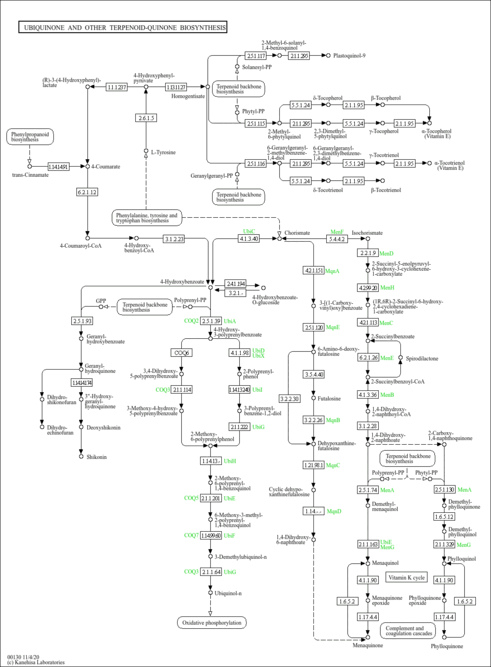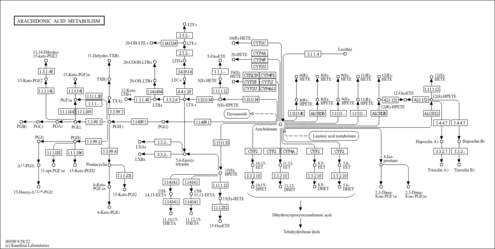Showing metabocard for Iron (HMDB0015531)
Enzymes
- General function:
- Involved in heme oxygenase (decyclizing) activity
- Specific function:
- Heme oxygenase cleaves the heme ring at the alpha methene bridge to form biliverdin. Biliverdin is subsequently converted to bilirubin by biliverdin reductase. Under physiological conditions, the activity of heme oxygenase is highest in the spleen, where senescent erythrocytes are sequestrated and destroyed. Heme oxygenase 2 could be implicated in the production of carbon monoxide in brain where it could act as a neurotransmitter.
- Gene Name:
- HMOX2
- Uniprot ID:
- P30519
- Molecular weight:
- 36032.615
Reactions
| Hemoglobin + FADH + Oxygen → Globin + Biliverdin + Carbon monoxide + Iron + FAD + Water | details |
- General function:
- Involved in heme oxygenase (decyclizing) activity
- Specific function:
- Heme oxygenase cleaves the heme ring at the alpha methene bridge to form biliverdin. Biliverdin is subsequently converted to bilirubin by biliverdin reductase. Under physiological conditions, the activity of heme oxygenase is highest in the spleen, where senescent erythrocytes are sequestrated and destroyed.
- Gene Name:
- HMOX1
- Uniprot ID:
- P09601
- Molecular weight:
- 32818.345
Reactions
| Hemoglobin + FADH + Oxygen → Globin + Biliverdin + Carbon monoxide + Iron + FAD + Water | details |
- General function:
- Involved in oxidoreductase activity
- Specific function:
- Stores iron in a soluble, non-toxic, readily available form. Important for iron homeostasis. Has ferroxidase activity. Iron is taken up in the ferrous form and deposited as ferric hydroxides after oxidation.
- Gene Name:
- FTMT
- Uniprot ID:
- Q8N4E7
- Molecular weight:
- 27537.885
Reactions
| Fe2+ + Hydrogen Ion + Oxygen → Iron + Water | details |
- General function:
- Involved in oxidoreductase activity
- Specific function:
- Ceruloplasmin is a blue, copper-binding (6-7 atoms per molecule) glycoprotein. It has ferroxidase activity oxidizing Fe(2+) to Fe(3+) without releasing radical oxygen species. It is involved in iron transport across the cell membrane. Provides Cu(2+) ions for the ascorbate-mediated deaminase degradation of the heparan sulfate chains of GPC1. May also play a role in fetal lung development or pulmonary antioxidant defense (By similarity).
- Gene Name:
- CP
- Uniprot ID:
- P00450
- Molecular weight:
- 122204.45
Reactions
| Fe2+ + Hydrogen Ion + Oxygen → Iron + Water | details |
- General function:
- Involved in cellular iron ion homeostasis
- Specific function:
- Promotes the biosynthesis of heme and assembly and repair of iron-sulfur clusters by delivering Fe(2+) to proteins involved in these pathways. May play a role in the protection against iron-catalyzed oxidative stress through its ability to catalyze the oxidation of Fe(2+) to Fe(3+); the oligomeric form but not the monomeric form has in vitro ferroxidase activity. May be able to store large amounts of iron in the form of a ferrihydrite mineral by oligomerization; however, the physiological relevance is unsure as reports are conflicting and the function has only been shown using heterologous overexpression systems. Modulates the RNA-binding activity of ACO1.
- Gene Name:
- FXN
- Uniprot ID:
- Q16595
- Molecular weight:
- 23134.895
Reactions
| Fe2+ + Hydrogen Ion + Oxygen → Iron + Water | details |
- General function:
- Involved in oxidoreductase activity
- Specific function:
- Stores iron in a soluble, non-toxic, readily available form. Important for iron homeostasis. Has ferroxidase activity. Iron is taken up in the ferrous form and deposited as ferric hydroxides after oxidation. Also plays a role in delivery of iron to cells. Mediates iron uptake in capsule cells of the developing kidney (By similarity).
- Gene Name:
- FTH1
- Uniprot ID:
- P02794
- Molecular weight:
- 21225.47
Reactions
| Fe2+ + Hydrogen Ion + Oxygen → Iron + Water | details |

